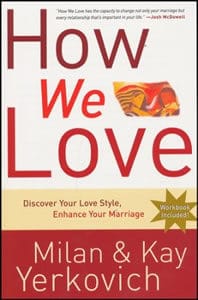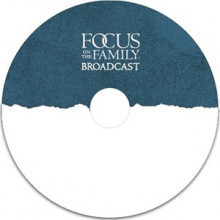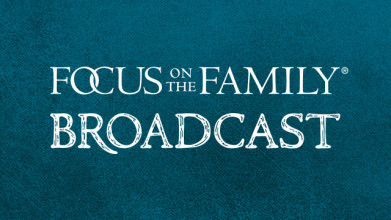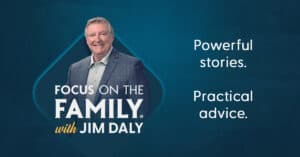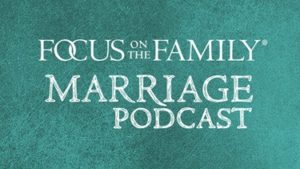Preview:
Kay Yerkovich: Until we understood the root was attachment and we started working at the root. Uh, and I took ownership of that avoider part of me. And he took ownership of the pleaser. And we begin to individually work on our sanctification in that way.
Milan Yerkovich: But iron sharpens iron, so one man sharpens another. So we talked to each other about our fears, how we scared each other.
End of Preview
John Fuller: Milan and Kay Yerkovich describing how you can discover your love style. And they’re with us today on Focus on the Family. Your host is Focus President and author Jim Daly, and I’m John Fuller.
Jim Daly: Okay, the first thing- it makes you chuckle to think about what’s your love style? (laughing) Remember, for those of us old enough, you think of the Love Boat or something like that. (laughter) But your love style is really important. And, you know, just like so many personality traits that we possess, each of us have a love style. Uh, we talked to Gary Chapman about, uh, your love language. And today we wanna talk about those things that are both positive and not so positive that tear your relationship apart.
John: And this is a really encouraging discussion I think we have ahead of us. Uh, so if you’re in what’s feeling like kind of a ho hum marriage, I think you’ll get some good tools to really take it, uh, a little deeper and, and to have greater intimacy. Uh, the Yerkovich’s have written extensively about this concept of love style. And, uh, the book that we’ll be, uh, talking about today most specifically is How We Love: Discover Your Love Style and Enhance Your Marriage.
Jim: Milan and Kay, welcome back to Focus on the Family.
Kay: Oh, thank you so much.
Milan: Thank you. We’re glad to be here.
Jim: Hey, let’s start right there. You know, at first, uh, I wanted to ask that question for that, uh, fairly newly married couple. But I think it applies to all of us. I mean, Jean and I have been married almost 30 years. And this kind of information is still very relevant and helpful to us. And I’m assuming even a couple married 50 years will benefit. But when you’re looking at, uh, the years that have gone by, it would’ve been so great to have this kind of discussion or to know about this information 20 years ago. You know, the first three, four-
Kay: Oh yes.
Jim: … 10 years of our marriage. So let’s talk about those styles that you’ve discovered in how we love, uh, talk about the five that you, um, express to couples to help them communicate better.
Milan: First, the secure attachment style is a person that has a decent sense of self, that they’re worthy of someone doing something for them and they can go and ask for help. They tend to see relationships as a place that they want to get relief. There are so many people in this world that don’t go to relationship for relief. They go to substances, addictions, to make those uncomfortable feelings go away. And if we look at the person of Christ, he could give to people, he could receive. He could say what he needed. He could ask for help. He was the secure attachment. And he’s our model as to what secure attachment looks like. And I think we, uh, don’t really appreciate that only a few of us would have an experience at our homes that would cause us to look like that as, as adolescents and adults. To have that-
Jim: Well, in fact, in-
Milan: … freedom.
Jim: … in your book you talk about how our childhood really does form these attitudes-
Milan: Yes.
Jim: … and, and behaviors in us. And, and we see that. I mean, that’s one of the things, uh, that we see here at Focus on the Family so often. How do we, uh, begin to arrest and understand that?
Milan: Well, I think the first thing we have to learn is that early experience, Kay, is what really sets us up for our future expectations. And we either had that secure attachment or we had one that wasn’t quite as secure.
Kay: I don’t think people really understand how important those formative years really are. Uh, we take everything in in those first two years of our life in a non-verbal way.
Milan: Mm-hmm.
Kay: We don’t have words yet. So we’re taking in facial expressions and voice tones. And they’re building implicit memories which are something that we remember in a feeling state in our body. They’re sort of wordless memories. We actually remember them for our entire lives. Uh, but they- they’re remembered in a, a state of feelings in response to other people. And so in the first two years of life, those are the implicit memories that they- they’re with us for the rest of our lives. And I was talking to a young man, uh, this week and he just had a new baby. And he couldn’t tolerate her crying. I mean, he literally went through the roof. And we, we begin to talk. And he says, I don’t understand my response. Well, as we begin to look at his own history, when he was two, he had a baby brother born that never stopped crying for two years. He was so difficult. And I said, “Can you imagine the feeling that you’re having in your body is almost like something you would feel as a two-year-old when you just wanted to hold your ears and scream?” And he started weeping.
Milan: Hm.
Kay: And he said, “I never thought of that.” But he said, “My mom told me that I used to go hide in the closet.” So these are the power of these early memories. And we, we don’t always know how they impact us later in life. So the secure connector is where we’re gonna head, but these broken love styles, um, come out of things that we often don’t even remember. And so they’re so normal to us that we don’t even know we’re doing it.
Jim: Um, Kay, uh, let me press you a little bit.
Kay: Sure.
Jim: Um, because folks that are listening are thinking, eh, psychology and scripture-
Kay: Right.
Jim: … and, you know, does that really count? I mean, I’m a two-year-old at that point. The Lord can work all that out. Talk about that blend from the outset here. Because so often, uh, you know, we in the Christian community can be critical of science-
Kay: Absolutely.
Jim: … but really, uh, what the Christian belief system does is prove what scientists are discovering. I mean, w- we-
Kay: Yes.
Jim: … uh, have an understanding as Christians about what scientists are looking at because we believe in the creator, we believe there’s order in the universe and those kinds of things. But talk about that junction for the skeptic right now that’s hearing us going this is psychobabble.
Milan: Well, we, we may not like science until we need a heart bypass and then we’ll-
Jim: Right.
Milan: … you know? And then we go, uh, sign me up. Because it h- it really hurts right now. But really all this is is observing how the mind should be developed. We don’t think of parents as, uh, brain shapers but they’re truly shaping the brain of the child. And the early experiences, God invented this. This is about God’s invention of attachment. The human being has the longest attachment period of all the mammals on the planet. And God created this extensive period of time where a child would be looked at with this l- lit up mom and the child would respond back. And so there’s a strong sense of togetherness that is built very early on, not just in our left brain, which is our cognitive reasoning, but in the right brain of feeling states. It feels comfortable to be next to you. Or it feels uncomfortable to be next to you.
Jim: Yeah.
Milan: So really all science has done is they’ve observed God’s creation of attachment.
Jim: Right.
Milan: And they have made studies to say what has gone really well? And when it doesn’t go so well, what are the ramifications in a person’s mind? And then that leads us to many things, of course, in the whole department of sin and brokenness. But one of the things it leads us to are these broken or wounded attachment styles.
Jim: Now we’ve talked about that, that secure attachment. Let’s talk about the others that are coming out of the pain. In fact, vacillator is another one. Talk about vacillator.
Milan: Sure.
Milan: Well a vacillator is a person who came from a home where perhaps they had intermittent connection with their parents. Intermittent connection meaning I see you. I give you attention. And then all of a sudden, I’ve pulled away from you and I’ve gone dark. I’ve gone dark because I’m inattentive, I’m preoccupied myself as a parent. Uh, I am busy. Uh, I am- have my own issues of- where I cannot see you because I’m preoccupied with something else. So the child never knows. Or I have an addiction or I’m fighting with the spouse. And so I, I then- the child feels alone. Then the parent re-engages with them at a time unpredictable to the child. And the child feels this ambivalence from the parent. And the ambivalence of I don’t know when I’m gonna be connected with. But they tend to value connection at a very high value. And that becomes their primary desire, is to have intense connection that never goes away. So when they grow up and enter into relationship, they enter into relationship with a very high expectation and hope of a connection that will never feel as though it’s going away, or will stop, or will cease or will be intermittent. And so they have an intense desire for perpetual connection. When their spouse averts their gaze, turns their back, is busy, they get very agitated on the inside. Then they get angry at the spouse for somehow abandoning them. Now they don’t use the word abandon. They just say, “I don’t like how I’m feeling right now, and you made me feel that way.” And so they get angry. They’re the protesters that say, “Why did you do that? Why did you make me feel this way?” So they are the love/hate, hot/cold, in/out, on/off spouses. Bright, dark. Uh, in a moment’s cha- kind of like the weather here in Colorado Springs. (laughter) You know, maybe, maybe on a- on a sunny day in the summer where it’s a beautiful day, then all of a sudden, the clouds come over and it’s dark.
Jim: Huh.
Milan: And this would be the vacillator imprint. It’s also in the literature called the ambivalent or preoccupied. Because I’m in and out, on and off, and I am preoccupied. Because I’m always thinking about, “What’s Jim thinking of me right now? Does he appreciate me? Does he value me? Does he wanna be with me? Does he not wanna be with me? He gave John a bigger hug-
John: These are my thoughts all the time.
Milan: Yeah, he gave John a bigger hug than he gave me. So maybe he likes John better. And so this preoccupation-
Jim: Huh.
Milan: … of relation, and they’re hyper vigilant, always watching.
Jim: Okay. So that’s the vacillator. Kay, y- you write in the book your own personal story of being the avoider.
Kay: Yes.
Jim: So as an expert in that category-
Kay: I’m an expert in the avoider.
Jim: What is avoider?
Kay: Well, I lived for 15 years with this love style, not really realizing that, um, my family didn’t really bond on any emotional level when I was growing up. My parents loved me. Um, we had nice dinners at my house. But we never had any personal conversations. And if I had a feeling- if I was sad, my dad said, “You better stop crying or I’m gonna give you something to cry about.”
Jim: Famous line (laughing).
Kay: Famous line. Or “Go to your room until you have your happy face.” And my mom just got highly anxious. So there was this underlying message of feelings are something we don’t do. Feelings are something that we dismiss. Feelings are something we don’t move into. We are always trying to fix them and move away from them. And so I got very good at, first of all, just not showing my feelings. And over time, not even really knowing what they were. So if you ask an avoider how they are, they really only have one answer. Fine.
Jim: Yeah.
Kay: Uh, and I can’t say that wasn’t true. I sort of existed in this, like, very midline kind of a, a level where I was never very happy, and I was never very sad-
Jim: So steady?
Kay: Steady. And a lot of people marry avoiders ’cause we’re very predictable and we’re very steady. And what people don’t realize until usually they marry us, is that we don’t really have any range of emotion. We really can’t connect on any emotional level. I don’t have memories of comfort from my childhood where a parent really noticed I was not doing well. And, and sought out to kind of understand what’s deep in my heart. And so I couldn’t describe what was deep in my heart. I had no words, uh, for internal experiences. And it was just a place that I never developed. And I, I didn’t realize until the 15-year mark that when you wanted closeness, Milan, I really didn’t know what you were talking about. Uh-
Milan: Mm-hmm.
Kay: … this was just a foreign concept to me. And a lot of people think their avoider spouses are holding out on them. And y- you know what I want. You just won’t give it to me. And honestly, avoiders don’t even know what they feel. They don’t know how to comfort you. Uh, they don’t know how to have empathy. Um, I mean, what was it like being married to me?
Jim: (laughter) I’m glad you asked that question-
Kay: Yeah. I was gonna say, I won’t- I- I’ll be brave and ask that.
Jim: Yeah (laughing)-
Milan: Well, it was hard to feel like I could capture you or that I could pull you into a place that I could feel as though there was something substantive and meaningful. I appreciate the point Kay made because a lot of times we- a person who’s married to an avoider would believe that they are just holding out. But truly, Kay did not have the words to be able to describe how she felt. She’s no longer an avoider, by the way. And I, I’m happy to announce that.
Kay: (laughs) Yeah. Worked hard my- to get-
Milan: Uh, she’s- she’s a recovered avoider-
Kay: … toward a secure connector.
Milan: She’s now that secure attachment.
Kay: That was my sanctification-
Jim: And that’s the goal for everybody.
Milan: That’s the goal for everybody, is to not stay in these wounded states. It’s to move out of that. And I would have to say that it- your, your distance from me was something that maybe we can talk about a little bit later, but it was the very thing that triggered my childhood, her distancing. So, uh, that was a part of the chase-
Jim: I mean, that was your wound-
Milan: Yeah, that was my wound-
Jim: … when someone was distanced-
Milan: Yeah, yeah.
Jim: Let me ask you about that because, um, it’s intriguing to me and in part I’m always asking are these mechanisms that God provides us for a period of time to cope with our environment?
Milan: Mm-hmm.
Jim: And I, I don’t know. ‘Cause we talk about them in positive and negative context. But for me, I, I would probably lean like you, Kay, toward the avoider ’cause of my childhood.
Kay: Right.
Jim: I mean, it’s total chaos-
Kay: I read your book. It’s, it was very hard.
Jim: A- yeah. Would you say that would be a classic-?
Kay: Yes.
Jim: So I mean, one of Jean’s things would be that, you know, I struggle being emotionally attached to her in certain ways.
Kay: Right.
Jim: And I’m mindful of that. But, but the difficulty in that is I’m always saying, well, Lord, those circumstances that I was in, um, did- was that a protection mechanism that you-
Kay: Yes, I-
Jim: … you’ve given me?
Kay: … I think all these are protective mechanisms. And they work. In my family, it was way more comfortable not to show my feelings. It was way more comfortable the few times I did cry, I went to my room. Um, I went on a walk. I always moved away from people when I was sad. Or when a feeling would be too much to handle and keep down. And of course I did that in my marriage for the first 15 years. He never saw me cry. So yes, as a child, they’re very protective. But they become so automatic, we don’t even know what’s animating us as an adult. And so I had to learn to develop a vocabulary for feelings. I had to learn to go back and repair the places where I just didn’t develop.
Jim: Ah.
Kay: And one of the huge things for me as an avoider was to learn to take a feeling word list and to refer to it often so that I could start to have a more of a knowledge about what do I feel because feelings link to needs.
Jim: Y- you gotta fill that in for me.
Kay: Okay. If you go to our website and you go to freebies, there’s a list, uh, a document there called Soul Words. And it’s also in our book. It’s just a list of words that are feelings that describe what’s inside a person.
Jim: Do you have some examples?
Kay: Oh my goodness. Um, sad, jealous, betrayed, um-
Milan: Humiliated, abandoned-
Kay: Ashamed. Um-
Jim: So are these things, I mean, literally you have a list, and you’ll say to Milan, I’m feeling this. And point to it or-
Kay: Well, for now, I can identify because … But for two years, I had that list in my journal. I had it in my bible. I had it in my car. I had it in my purse. And-
Jim: Wow.
Kay: … I, I purposed to look at it and say, okay, if I was feeling a feeling right now, what might it be? And at first, I was sort of guessing. But then I begin to learn to read my body because avoiders turn off their body, which is part of how we know what we’re feeling. Our body is usually the first signal that we’re feeling something. We get angry, we get a tight, tense, uh, shoulders. Or, or we’re sad and we, we start to feel an anxious stomach. So I begin to pay attention to my body. And at about the two-year mark, I actually started to realize, hey, I, I actually know what I feel right now.
Milan: Mm-hmm.
Kay: And I could put words to it. So this is a very important growth goal.
Milan: Mm.
Jim: We ask our audiences all the time does God have emotions from Genesis to Revelation? Do we see God i- you know, with his emotions? And everybody goes, yeah. And I go, lots of them? Yeah. Well, what are they? Jealous and envy. I have anger. I have hurt. I have sadness. I have grief. I have joy. God has all these feelings. I have love. And He, He knows how to name them. He knows why He has them. And He knows what He wants to do with them. And we’re made in the image and likeness of God, aren’t we? So for us to have access to our emotional selves, this is called emotional intelligence. Our God’s highly emotionally intelligent. This isn’t psychobabble. We’re just copying God.
Jim: Mm.
John: You’re listening to Milan and Kay Yerkovich today on Focus on the family. And you’ll find their book How We Love, and a number of other helpful resources, at focusonthefamily.com/broadcast. Let’s continue the conversation with Milan and Kay Yerkovich.
Jim: Okay. We’ve talked about that secure connector type. And that’s the goal. That’s where you wanna get to.
Kay: Right.
Jim: And we’re gonna talk more about how you do that.
Milan: Mm-hmm.
Jim: We’ve mentioned the, the vacillator, the avoider. Let’s talk about the pleaser. And what we’re doing here for you is identifying, perhaps through the description of these, what you might be-
Kay: Right.
Jim: … but there is that online survey you could take. And just go to, uh, our website and you’ll be able to do that. We’ll link to the Yerkovich’s, uh, survey that you can do. So talk about the pleaser.
Milan: Well, you were right a moment ago. I liked how you put it. These are stress management coping mechanisms for us as children. What serves us best to survive what we’re going through at the time? For me, I had an angry parent, an explosive parent, and so I found that to be quiet, to be a good boy, to try to do nice things around the house, to stay in and maybe clean or straighten things up, to really emotionally care take the parent. What happened to me was- is I would stay in for the purpose of trying to figure out are things improving? Are they getting better? Are they getting worse? What can I do? And so why do good kids come upon the scene? They’re trying to be good to manage what’s happening around them to make somebody happier. So that’s your point exactly, uh, Jim when you talk about how we cope. And it serves us well. So that’s what I did as a child. As a result of that, pleasers walk into adulthood, and they don’t have a strong sense of self. They’re very tuned into other. But if you ask them, well, where do you wanna go for lunch? They’ll say, well, wherever you wanna go for lunch. You know, they don’t have a strong sense of opinion. Secondly, they, they have very weak boundaries. If you need somebody to do something at the last minute, as a pleaser and they’ll get it done for you, you know, even if it’s midnight. Um, they don’t have a strong sense of the ability to say no. That’s boundaries. And then they won’t get angry. Why? Because anger’s a separating emotion.
Jim: Huh.
Milan: If I get angry at you, that means we’re gonna have some distance and separation. So pleasers, unlike Kay who could tolerate separateness, pleasers need closeness in order to feel okay. And I’m okay if you think I’m okay. So I’m very other dependent upon you to make me feel okay. If you’re smiling, then I can smile inside. So that’s what I grew up with. So it took a lot of work for me to get to a place where I could learn to be strong and autonomous by myself without your approval or yours or, or even Kay’s.
Kay: Aren’t you gonna ask me, like, how it was to be married to a pleaser? (laughter)
Milan: Well, I was just gonna- I was just gonna- [crosstalk 00:20:25] I was just gonna-
Jim: I- I wasn’t gonna ask that question.
Milan: Did you notice I was just turning this way? (laughter)
Kay: I was wondering. Okay. Very good.
Jim: Good conflict there. I like that.
Milan: So what was it like to be married to a- an unrecovered pleaser who had no idea he was.
Kay: You know, you were so nice, and I kept feeling like why does it bug me so much that you’re so nice-
Milan: It was nauseatingly nice, wasn’t it?
Kay: No I- as I look back now, you used to ask me all the time, “How are you? How are you?” And of course I only would answer, “Fine.”
Jim: (laughs)
Kay: But I could say now that I understand it. It never felt like it was really about me. It felt like it was more for you. Like if o- there was one right answer. I’m great, I’m fine, you’re amazing, you’re the most wonderful husband I could ever have.
Milan: So it was a disingenuous question. It was really not about you. It was really about me, wasn’t it?
Kay: Right.
Milan: How are you?
Kay: Right.
Jim: Oh, that’s interesting you picked that up-
Kay: I did pick that up-
Jim: … intuitively.
Kay: … on- yes.
Jim: Yeah.
Kay: So I think the other thing that was frustrating is, you know, the lack of boundaries, you know, you- you could be very overbooked trying to help everyone and, you know, be nice to everybody. And, uh, sometimes, uh, that took away some time that we might’ve had at the home. But-
Milan: And I’ve completely grown out of that, haven’t I?
Kay: (laughter) You- yeah, you have. (laughter) In fact, no one-
Jim: He’s winking.
Kay: … kind of the, the interesting things about these love styles is they’re, they’re kind of- we could also think of them as a stress response.
Milan: Mm-hmm.
Kay: So avoiders flee. You know, you have your fight, flight, freeze. Pleasers get-
Milan: Freeze.
Kay: … very- they freeze if you’re mad at them or there’s conflict. They get, you know, rattled. And, uh, vacillators just fight.
Milan: Vacillator’s fight. Mm-hmm.
Kay: So we have these stress responses that sort of go with certain reactions that are very predictable.
Jim: Right. And the last one, I think it’s the last one, is chaotic.
Kay: Yes.
Jim: Um, describe chaotic. That seems to be the worst possible state. I- I’m not sure that they’re measured-
Kay: It is.
Jim: … here.
Kay: No, it is.
Jim: That one looked more destructive than the others. But talk about the chaotic, uh, controller victim mentality.
Milan: Well, well Jim, just a little while ago, you said my childhood was so chaotic.
Jim: Right.
Milan: And what was- when we stop and say what was that like? And, and having read your book, it’s a home where there’s unpredictability, where a person doesn’t know they’re safe. Where the parents is supposed to bre- be providing security and safety, the parent is simultaneously dangerous, abusive, neglectful, harmful or so addicted or at a- such a mentally unhealthy place that they’re, perhaps, at a level or lower than the child.
Jim: Huh.
Milan: So what does the child do? The child doesn’t know what is predictable. There’s, if you will, another synonym for chaotic is disorganized. So there’s this disorganized attachment, not just a disorganized world, but a disorganized attachment experience. As one researcher coined it, it’s called fright without solutions. The child is in a frightened state without any solution to that. And the child is left in this unsettled state. And so they often then find themselves moving into one of two modes, a highly controlling mode where they can predict their world, which has high levels of rigidity to it. Because if I have a rigid, controlled world then I’m not left unsettled anymore because I know what’s gonna happen around me every day. It just means that you better do what I say so that you’re not doing something different that rattles me. Or they might end up more of a victim type.
Kay: Yeah. The victim is just somebody who learned to tolerate the intolerable.
Milan: Mm-hmm.
Kay: This is the more compliant child in this home that just learns if they stay under the radar, if they hide under the bed, um, that that’s their way of coping. The trouble is they; they have very little sense of self or boundaries and it’s very hard for them to stand up and and say no to someone who’s controlling or abusive themselves. Because they’ve already learned to tolerate the intolerable. That’s normal.
John: Such great insights from Milan and Kay Yerkovich today on Focus on the Family. And, uh, we’re gonna pause right there and bring the balance of the conversation to you tomorrow.
Jim: Milan and Kay have so much more good stuff to share on this topic of love styles. Uh, each of those, the avoider, the pleaser, the vacillator, the controller, and the victim all resonate with us in one way or another. And by discovering your love style and how it shapes your behavior, beliefs and expectations, you’re gonna be able to strengthen your marriage and make it thrive. And let me remind you that Focus on the Family is here for you. We know there are ups and downs in marriage. That’s just the way life is. And when those harder times come, we can help.
John: Yeah. We have a team of caring, Christian counselors who can listen to your situation. Uh, they’ll pray with you. They’ll offer some resources and help you get on the right path to healing.
Jim: We also have our Hope Restored program for relationships that are in real trouble. Uh, this is a four-day marriage intensive that offers hope and healing for you and your spouse. And people who have attended say it is life changing. How about that for a testimony?
John: Mm-hmm.
Jim: In our survey work done two years after those who attend, 80% of those couples are still together and doing better. If you’re in a place of brokenness in your marriage, get in touch with us. The Lord does amazing things in those intensives. And we also have Milan and Kay’s book on the love styles we talked about today. It’s titled How We Love, and you can get that directly from Focus on the Family. In fact, when you make a monthly pledge, uh, to the ministry of Focus, of any amount, we’ll send you a copy as our way of saying thank you for partnering in ministry together. And if you can’t commit a monthly amount, uh, we understand. Uh, we’ll send that to you for a one-time gift as well.
John: Yeah. Donate as you can. Learn more about Hope Restored. Uh, schedule a time to talk with one of our counselors. And request your copy of the book How We Love. Our number is 800, the letter A, and the word FAMILY. 800-232-6459. Or stop by focusonthefamily.com/broadcast. On behalf of Jim Daly and the entire team, thanks for joining us today for Focus on the Family. We’ll be back tomorrow with more from the Yerkovich’s as we once again help you and your family thrive in Christ.










